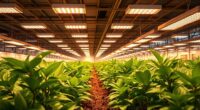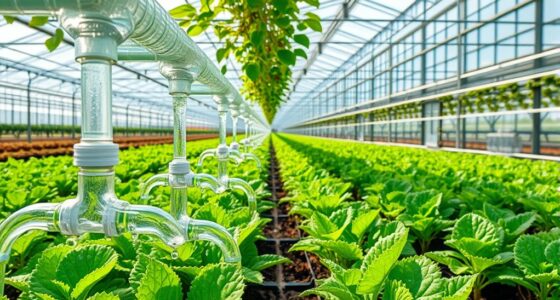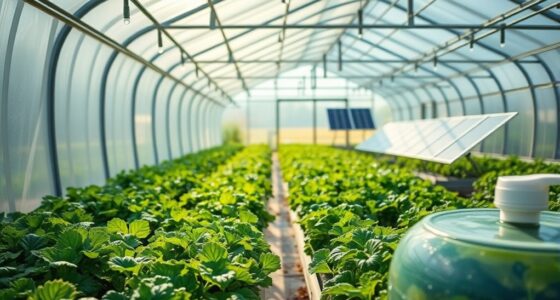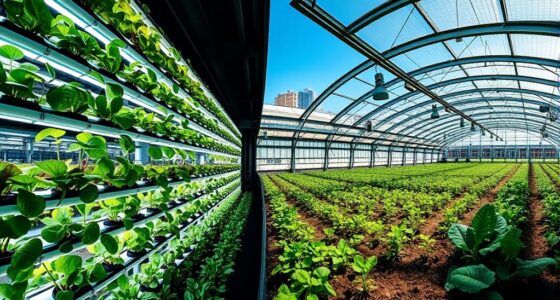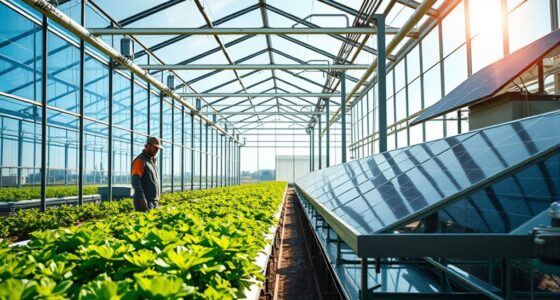The rise of hydroponic greenhouses is a game-changer in sustainable farming. By using nutrient-rich water instead of soil, you can conserve up to 90% more water while boosting crop yields dramatically. Techniques like Deep Water Culture and Ebb and Flow maximize efficiency, allowing for year-round production. This modern approach not only supports local food supply but also minimizes environmental impact. If you’re interested in exploring the benefits and innovations in this field, there’s much more to discover.
Key Takeaways
- Hydroponic greenhouses utilize nutrient-rich water, reducing water usage by up to 90% and promoting sustainable agricultural practices.
- They enable year-round crop production, enhancing food security and minimizing reliance on imported produce.
- Advanced hydroponic systems, such as vertical farming and automation, optimize space and boost yields significantly.
- The method reduces chemical usage and soil erosion, fostering healthier ecosystems and sustainable farming environments.
- Growing consumer demand for fresh, local food drives innovation in hydroponics, creating new market opportunities in urban agriculture.
Understanding Hydroponics: The Basics
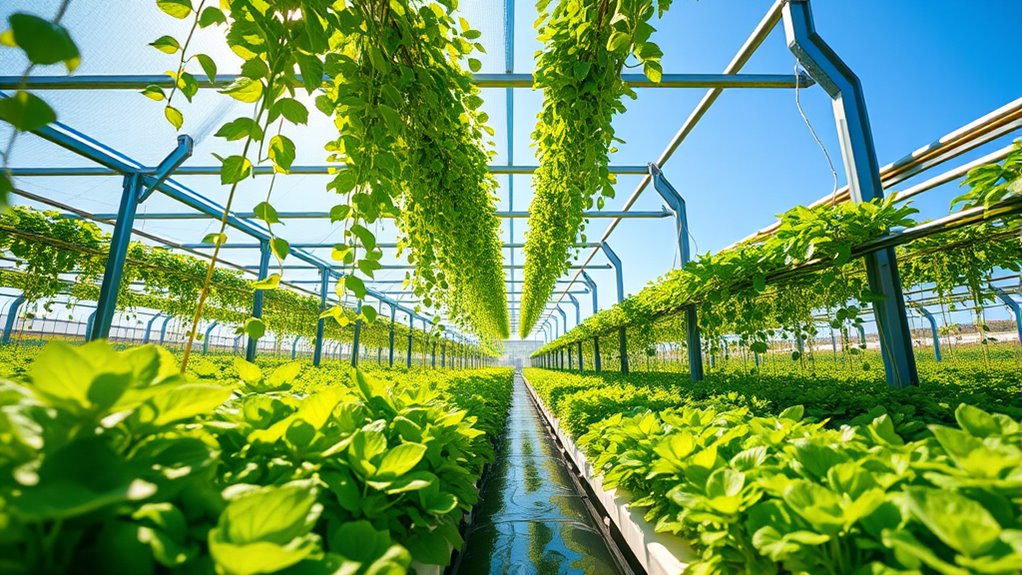
Hydroponics is revolutionizing the way we think about growing plants. This innovative method cultivates crops without soil, relying instead on nutrient-rich water solutions. Though the term “hydroponic” emerged in the 1930s, the practice has roots as far back as the 17th century. By enabling precise control over the growing environment, hydroponics accelerates growth rates and boosts yields. Plants receive essential elements directly through water, allowing for faster growth and higher productivity. In addition, using hydroponics can lead to improved nutrient absorption due to the direct delivery of nutrients to the roots. You can explore various hydroponic systems, like Deep Water Culture, Wick Systems, and Aeroponics, each offering unique benefits. Essential components, including reservoirs, pumps, and nutrient solutions, work together to support plant growth. Backyard greenhouses can be an excellent environment for hydroponic systems, allowing gardeners to maximize their crop output. Additionally, incorporating sustainable practices within your greenhouse can further enhance the efficiency and ecological impact of your hydroponic setup. With hydroponics, you can grow a diverse range of plants while efficiently utilizing resources, paving the way for a more sustainable agricultural future.
Key Advantages of Hydroponic Greenhouses

The advantages of hydroponic greenhouses extend far beyond traditional gardening methods.
You’ll save up to 90% more water, thanks to efficient recycling and reuse. With less land needed, you can maximize urban space while promoting sustainability by reducing chemical use. Hydroponics uses significantly less water than traditional farming, making it an ideal solution for areas facing water shortages. Additionally, the emphasis on environmental interactions in hydroponics showcases how sustainable practices can enhance development. Hydroponic systems can also significantly reduce overall resource consumption, further contributing to environmental sustainability. Moreover, campgrounds often feature options for integrating local produce into meals, which aligns with the goals of sustainability in food sourcing.
Year-round production guarantees you have fresh crops regardless of weather, enhancing food security. Additionally, plants grow up to twice as fast, yielding higher quantities of healthier, more flavorful produce.
Automation cuts labor costs, boosting profitability and allowing for quick local deliveries, which minimizes transportation expenses.
Hydroponics also supports diverse crop cultivation, adapting to market demands easily. Embracing hydroponic greenhouses means you’re stepping into the future of sustainable, efficient farming.
Challenges and Limitations of Hydroponic Systems

While hydroponic systems offer numerous benefits, they also come with a host of challenges that can be intimidating for growers. The initial setup can be costly, requiring specialized equipment and technical expertise. You’ll need to rely on electricity for lights, pumps, and climate control, making you vulnerable to power outages if backup systems aren’t in place. Disease management poses another hurdle; waterborne diseases can spread rapidly in closed environments, demanding continuous monitoring. Additionally, not all crops thrive in hydroponic systems, limiting your options. Maintaining nutrient balance is essential but tricky, requiring constant adjustments. Finally, while hydroponics uses less water, the environmental footprint of equipment production and energy consumption remains a concern. Reduced water consumption can help mitigate some environmental impacts, but it does not eliminate them entirely.
Popular Hydroponic Techniques and Methods
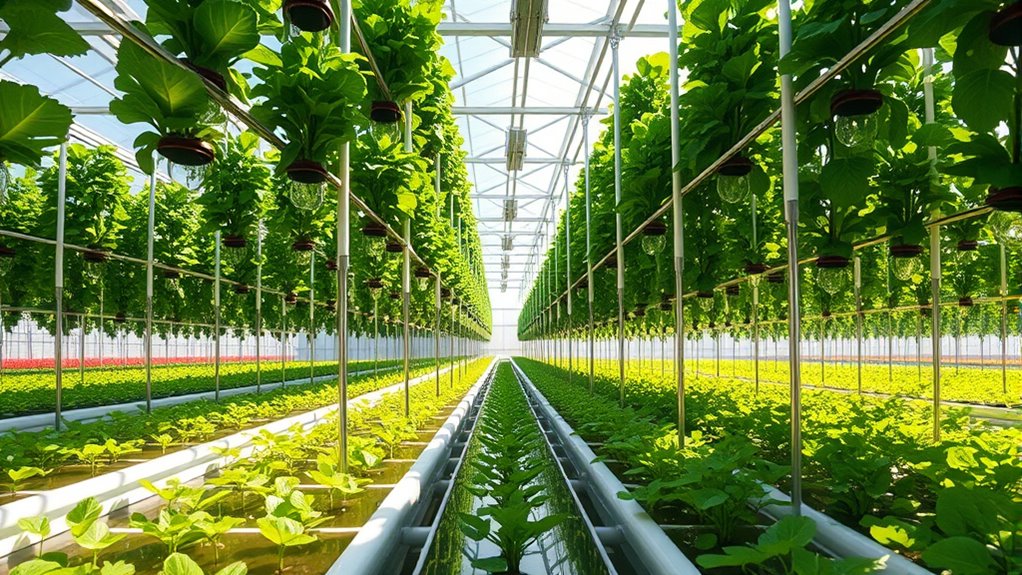
Maneuvering the challenges of hydroponic systems opens the door to a variety of popular techniques and methods that can suit different needs and preferences.
You might consider the Wick System for its simplicity, using wicks to deliver nutrients without pumps. For larger plants, Deep Water Culture (DWC) keeps roots submerged in nutrient-rich solutions, which reduces effort for roots to search for nutrients compared to soil. This method also allows for high oxygen levels in the root zone, promoting faster growth. Additionally, understanding optimal conditions for plant growth in hydroponic systems can further enhance your success. Many hydroponic setups can be adapted to utilize family-friendly amenities similar to those found in water parks, providing a unique way to engage younger gardeners.
If you’re growing leafy greens, the Nutrient Film Technique (NFT) provides a constant flow of nutrients. Ebb and Flow, or Flood and Drain, periodically floods your grow bed, making it popular among home gardeners.
Finally, Aeroponics delivers nutrients as a mist, enhancing oxygen levels. Each method offers unique advantages, so choose one that aligns with your gardening goals and space.
Environmental Benefits of Hydroponic Farming
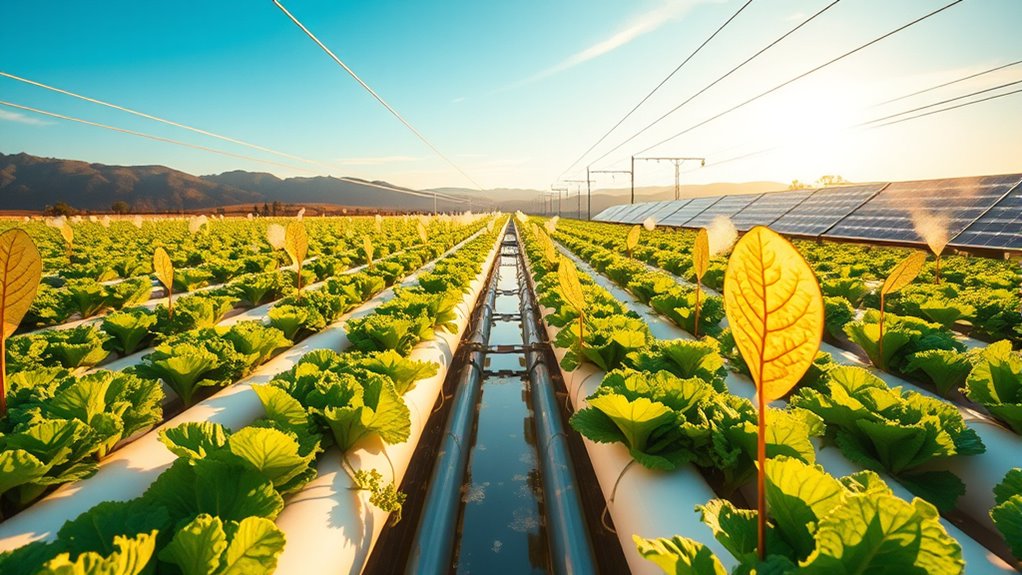
Hydroponic farming offers numerous environmental benefits that make it an attractive alternative to traditional agriculture. You’ll find that it uses up to 90% less water, which is essential for conservation. By eliminating soil, hydroponics prevents erosion and preserves natural resources. This method also reduces the need for harmful pesticides, promoting healthier ecosystems. Moreover, hydroponic systems use 98% less water compared to traditional farming methods, further showcasing their efficiency. Additionally, solar-powered irrigation systems enhance crop yields and efficiency, demonstrating how technology can support sustainable practices. With year-round production, you can enjoy a consistent food supply without seasonal limitations, decreasing reliance on imports. Hydroponics enhances food safety by minimizing soil-borne diseases and optimizes resource use, cutting down waste. Incorporating nutrient-dense ingredients like chia seeds in hydroponic systems can further improve the nutritional value of crops, as chia seeds are a plant-based source of omega-3s that can benefit overall health. Additionally, vertical farming techniques maximize space, making efficient use of land. Overall, hydroponics presents a sustainable approach to farming that greatly lessens environmental impact.
Economic Trends in Hydroponics
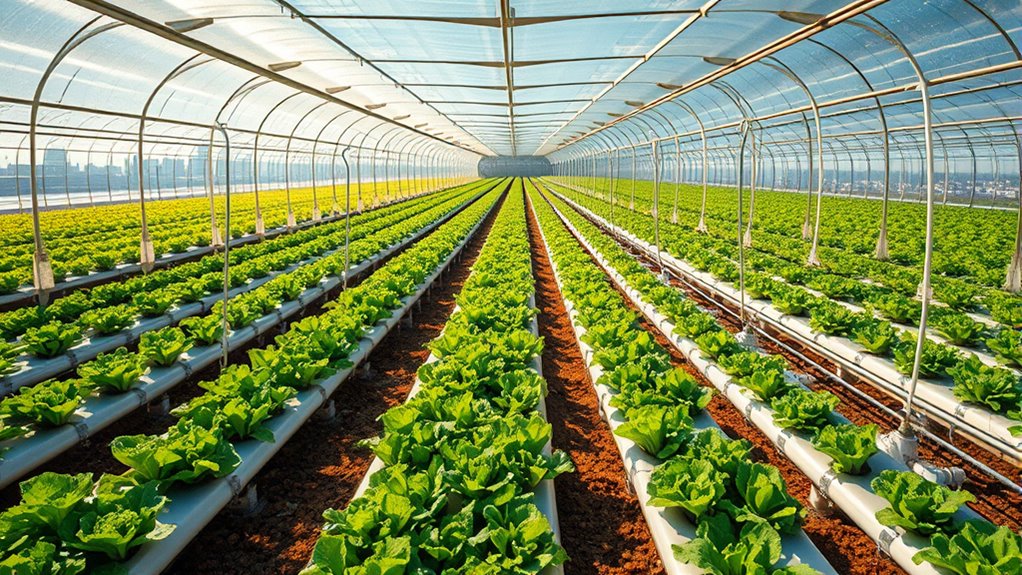
As the demand for sustainable and locally grown produce increases, the economic landscape of hydroponics is evolving rapidly.
While high initial costs and the need for technical expertise pose challenges, the benefits are significant. Hydroponic systems yield more per unit area and enable faster growth cycles, allowing for multiple harvests each year. This leads to reduced operational costs and premium pricing for quality produce. Additionally, hydroponics supports optimal nutrient absorption, which enhances crop quality and market value. Furthermore, the implementation of green technologies can significantly improve efficiency and sustainability in hydroponic farming. Investing in gold IRAs can also be a strategic way to support your financial security while engaging in sustainable practices. Moreover, diversifying crypto assets in your investment portfolio can provide additional financial stability in an evolving market.
High initial costs may challenge adoption, but hydroponics offers superior yields, faster growth, and premium pricing for exceptional produce.
Urban farming opportunities are expanding, driven by consumer preferences for fresh, local options. Financial institutions recognize the potential, providing support for innovative projects.
With a stable income stream from year-round production, you can navigate market competition and capitalize on the growing global demand for hydroponically grown crops.
Future Innovations in Hydroponic Technology
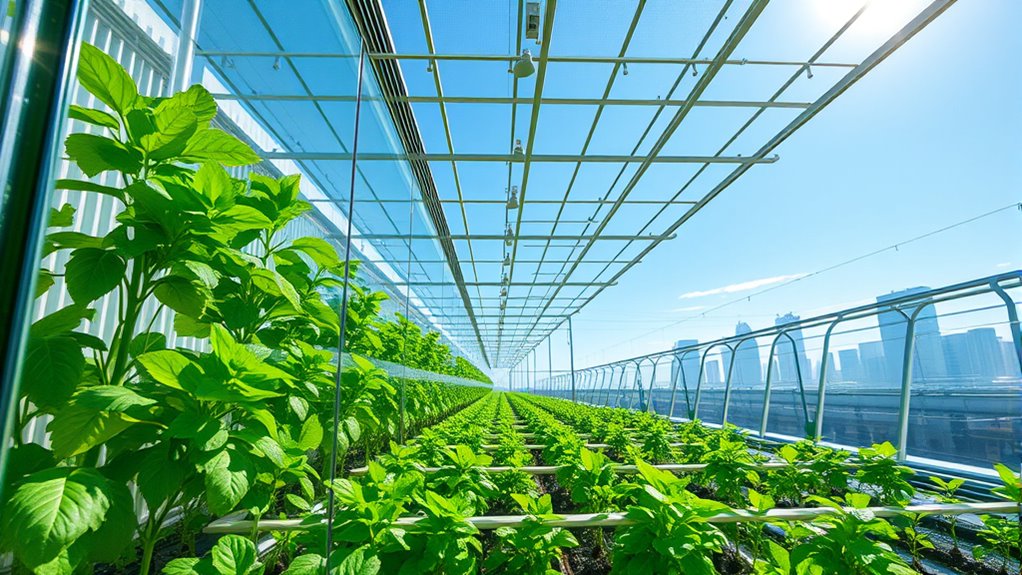
The rapid evolution of the hydroponics industry opens the door to exciting innovations that promise to enhance efficiency and sustainability.
You’ll see automation and AI taking center stage, optimizing environmental controls for plant growth. Compact vertical farming towers will save space while boosting yields, especially in urban areas. The integration of smart hydroponic systems will ensure real-time control of environmental parameters, further improving plant health and productivity. Additionally, the use of renewable energy sources like solar power can significantly reduce operational costs and carbon footprints. As seen in other sectors, such as electric vehicles, technological advancements can lead to greater sustainability. AI-powered tools can also assist in monitoring plant health and resource usage, further enhancing efficiency.
Solar-powered systems will reduce reliance on fossil fuels, promoting a greener future. Advanced LED and CMH grow lights will allow for customizable light spectrums, optimizing photosynthesis.
With smart sensors and automated nutrient delivery, you can achieve precise nutrient levels, enhancing growth. Modular systems will offer flexibility for various scales, while data analytics will help predict nutrient deficiencies and maximize yields.
These innovations are set to revolutionize hydroponic farming.
The Role of Hydroponics in Food Security
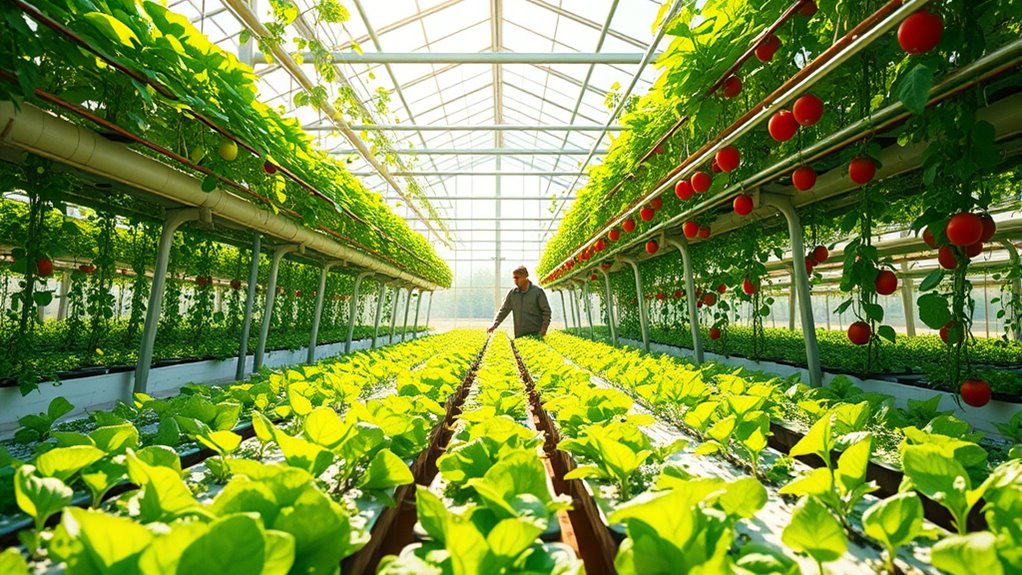
While traditional agriculture faces numerous challenges, innovative hydroponic systems offer a promising solution to enhance food security. You’ll find that hydroponics uses up to 90% less water than conventional farming, making it incredibly efficient. With the ability to produce crops year-round, you can enjoy a steady food supply, regardless of the weather. Plus, hydroponics can yield up to 20 times more per acre, ensuring more food can be grown on less land. This method is particularly beneficial in regions prone to droughts or floods, fostering climate resilience. By promoting local food production, hydroponics reduces reliance on imports, empowering communities and boosting food sovereignty. Additionally, goats are browsers and can thrive in hydroponic settings, potentially increasing the diversity of produce available. Ultimately, hydroponics stands as a key player in addressing global food security challenges, especially as it can minimize soil erosion and environmental pollution compared to traditional methods. Additionally, the use of renewable resources in hydroponics aligns with sustainable practices that support eco-friendly living.
Case Studies: Successful Hydroponic Greenhouses
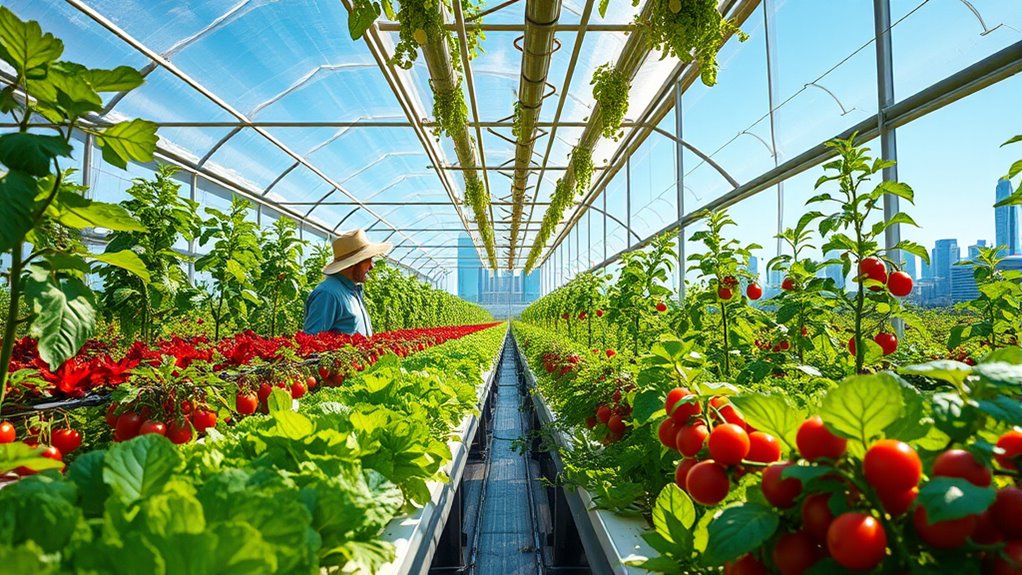
Hydroponic greenhouses are making waves in agricultural innovation, showcasing how effective these systems can be in real-world applications.
In Zaragoza, Spain, the HS Strawberry system exemplifies successful hydroponics, producing neutral day strawberries efficiently. With a focus on crops like lettuce and herbs, these systems thrive due to their adaptability and market demand for local produce. The HS Strawberry system has demonstrated robust performance, enhancing both plant health and yield maximization for growers.
Hydroponics uses 90% less water than traditional farming, leading to increased yields and improved crop quality. Plus, you can grow year-round, regardless of weather conditions.
Innovations like smart farming technologies and renewable energy integration further enhance sustainability. By converting existing greenhouses to hydroponics, you maximize space and streamline operations, meeting the growing demand for environmentally friendly agriculture.
Frequently Asked Questions
What Types of Crops Grow Best in Hydroponic Systems?
When you’re choosing crops for hydroponic systems, focus on leafy greens like spinach and kale, which thrive in compact spaces.
Herbs such as basil and mint are also excellent, providing year-round yields.
You can’t go wrong with tomatoes and strawberries, as they mature quickly and yield abundantly.
Cannabis is another strong option, benefiting from precise environmental control.
These crops offer high market demand, making them profitable choices for your hydroponic setup.
How Much Does It Cost to Start a Hydroponic Greenhouse?
Starting a hydroponic greenhouse can feel like breaking the bank, but it’s worth every penny.
You’ll typically need around ₹56 to ₹60 lakhs for greenhouse structures and an additional ₹30 to ₹34 lakhs for NFT systems per acre.
Don’t forget ongoing costs like nutrients and energy, which can add up to thousands annually.
While the initial investment is hefty, the potential for high yields makes it a worthwhile venture.
Can I Set up a Hydroponic System at Home?
Yes, you can set up a hydroponic system at home!
Start by gathering essential components like a fountain pump, tubing, and a water tank. Choose a dedicated space, ideally with vertical options for efficiency.
Maintain proper nutrient and pH levels, and guarantee you have the right lighting and environmental controls.
With a little planning and care, you’ll enjoy fresh produce year-round while conserving water and minimizing pests. It’s a rewarding project!
What Maintenance Is Required for Hydroponic Systems?
To maintain a hydroponic system, you’ll need to regularly monitor water quality, checking pH and nutrient levels.
Daily, inspect the system for wear and log data.
Weekly, adjust nutrients, top up water, and clean the system.
Monthly, refresh the reservoir and maintain the water pump.
Seasonally, disinfect the system and replace worn components.
How Do Hydroponic Systems Impact Soil Health?
While traditional farming digs deep into soil, hydroponic systems float above it, leaving the earth untouched.
By eliminating soil from the equation, you’re helping to conserve it from degradation and erosion. You’re also reducing chemical use that harms soil health.
With precise nutrient control, you guarantee plants thrive without depleting soil nutrients.
In doing so, you support sustainable practices that preserve arable land and promote environmental health, benefiting future generations.
Conclusion
As you explore the rise of hydroponic greenhouses, you’ll discover a sustainable farming revolution that promotes efficiency, conserves water, and enhances food security. Embracing innovative techniques, tackling challenges, and recognizing economic trends will empower you to appreciate the transformative potential of hydroponics. By investing in this technology, supporting local farmers, and advocating for sustainable practices, you contribute to a greener future—one where fresh produce flourishes, resources are preserved, and communities thrive in harmony with nature.

